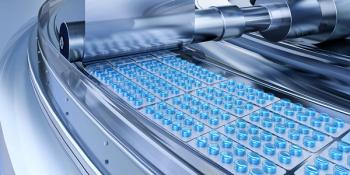
- Pharmaceutical Technology-05-02-2013
- Volume 37
- Issue 5
Controlling Ice Nucleation During the Freezing Step of Lyophilization
Lyophilization technologies for controlled nucleation.
Lyophilization, or freeze drying, is an important manufacturing step widely used to increase the stability of pharmaceutical and biological products. Developed during the 1940s, lyophilization produces a dry product that can be readily reconstituted to its original form by adding water when required (1). It prolongs product shelf life by inhibiting chemical, microbiological, and physical degradation pathways that occur in the presence of moisture, particularly where long periods of storage and transit prior to use are involved (1, 2).
PHOTO 24/MARIA TOUTOUDAKI/GETTY IMAGES; DAN WARD
The lyophilization process consists of three main stages—freezing (solidification), primary drying (ice sublimation), and secondary drying (moisture desorption)—and usually takes several days to complete. Multiple vials containing a liquid drug formulation are loaded on temperature-controlled shelves within a sterile chamber and cooled to low temperatures until completely solidified (2). After that, chamber pressure is reduced and shelf temperature is raised to remove the frozen solvent through sublimation. The remaining unfrozen solvent that is chemically bound to the solid product is removed by a desorption process (3). The drying process is concluded by stoppering the vials in the chamber, generally under a subambient pressure of inert gas. The final dry product, called a cake, usually occupies approx-imately the same volume as the initial liquid fill because of its high porosity (2). "To ensure that high quality products are consistently produced, it is crucial to be able to control and provide repeatability of the lyophilization cycles," says Joseph Brower, technology manager at IMA Life North America.
The freezing step
The freezing step is one of the most important steps in lyophilization because it determines the texture of the frozen material and consequently, the final morphological characteristics of the freeze-dried material and its biological activity stability (4). "Proper freezing creates the foundation for efficient and consistent freeze-drying cycles," says T.N. Thompson, president of Millrock Technology, a company that develops freeze drying/lyophilization systems for laboratory applications and cGMP production.
The three steps in the freezing process are nucleation, crystallization of the freeze concentrate, and for the maximal freeze concentrate, either freeze separation in eutectic products or concentration in amorphous products. The parameters of the freezing protocol directly affect pore size distribution and pore connectivity of the porous network of the freeze-dried matrix. The ice-crystal morphology determines both mass and heat transfer rates through the dry layer and as a result, freezing parameters have a strong influence on the total duration of the primary and secondary drying steps (4).
The nucleation process
During the freezing phase of a typical freeze-drying cycle, the nucleation process of which the first solid domains are formed occurs randomly in the vials. "In an uncontrolled environment, due to the lack of nucleation sites in pure systems, the formulation solution must be cooled down to temperatures that are significantly lower than the equilibrium freezing point (i.e., supercooled) to initialize formation of ice crystals," Brower explains.
The contents of individual vials often nucleate or begin freezing over a broad range of temperatures, "usually spanning 10–15 °C below the formulation's thermo-dynamic freezing point in a laboratory freeze dryer and 20 °C or greater in a cGMP Class 100 production dryer," says Mark Shon, vice-president of sales and marketing at SP Scientific. This supercooling phenomenon creates significant vial-to-vial heterogeneity in the solid microstructure, which significantly affects the subsequent drying processes. "To accommodate this heterogeneity, today's best practice is to design lyophilization processes for the worst-case scenarios; however, this strategy can result in excessively long drying cycles, broad product specifications, longer process development times, and nonoptimal product preservation," comments Cheryl Thierfelder, Praxair's business development manager.
It has long been recognized that one of the most important goals during the freezing step of lyophilization is to produce a uniform batch, which is a challenge due to the stochastic nature of nucleation. The random nature of nucleation, however, makes it difficult to control the nucleation temperature and maintain it within the desirable supercooling range.
Implications of uncontrolled nucleation
The nucleation behavior can affect several lyophilization process steps and product attributes. "The implications of uncontrolled nucleation are several-fold," says Shon. "First, since every vial can nucleate at a slightly different time and temperature, true vial-to-vial uniformity is really not achievable. We have seen a vial nucleate at -7 °C and another vial (of the same type with the same product) nucleate an hour later at -18 °C. These vials are now very different. They will dry at different rates and have a different pore structure, different cake structure, and different specific surface area."
Nucleation of freezing strongly influences the size of the resulting ice crystals. Studies have demonstrated that colder nucleation (i.e., higher degree of supercooling) generally produces smaller and more numerous ice crystals, which leave behind smaller pores upon sublimation in primary drying. "These smaller pores present a greater resistance to subsequent sublimation of the remaining ice. As a result, primary drying is slowed by cold nucleation temperatures," explains Thierfelder. "The longer cycles stemming from uncontrolled nucleation require increased investment in lyophilization capacity and higher operating costs. It also means greater risk as the product sits in a vulnerable multiday batch operation."
On the other hand, a lower degree of supercooling produces larger ice crystals that result in large pores during drying, reduced resistance to mass flow, and shorter drying times. "Studies have shown that primary drying times were extended 1–3% for every 1 °C change in ice-nucleation temperature (5, 6). Therefore, by reducing the degree of supercooling from, for example, 15 °C to 5 °C for uncontrolled and controlled nucleation respectively, the primary drying time can potentially be decreased by 10–30%, which is significant given the fact that primary drying may take days," says Brower.
"Reduction in primary drying time is one of the significant benefits of controlled nucleation," Shon adds. "A number of research groups have reported as much as a 40% reduction in primary drying times (7–9). This can have a significant financial impact on production as throughput can be significantly increased without increasing the number of expensive production dryers." Besides influencing the size of ice crystals, the nucleation behavior can also affect product yield in various ways. For example, previous research has shown that proteins tend to aggregate on the surface of ice (10–14). Colder nucleation tends to produce smaller ice crystals, which possess larger surface areas; therefore, colder nucleation creates increased aggregation stress on sensitive proteins.
Another potential source of yield loss in lyophilization arises from vial cracking. "The exact mechanisms for vial cracking are not well understood, but the problem seems to occur when certain formulation components are improperly frozen into metastable states that rearrange upon heating in primary drying, and sometimes this rearrangement creates sufficient force to crack the glass container," Thierfelder explains. "The temperature at which nucleation occurs affects the kinetics of the freezing process and can influence vial-cracking phenomena."
Uncontrolled nucleation can adversely affect product quality. "No matter how well engineered your process controls or how uniform your freeze-dryer's heat-transfer environment might be, vial-to-vial uniformity is impossible to achieve in the absence of controlled nucleation," Thierfelder notes. "The vials will nucleate at random temperatures and times, and therefore, have separate temperature histories, which will impart different properties to the freeze-dried product." Nucleation and freezing also affect the cosmetic properties of cakes with effects such as glazing, cake cracking, and stratification often resulting from problems during the freezing step. "Overall, it should be recognized that the traditional lack of control over nucleation behavior is poorly aligned with FDA's current emphasis on quality by design," Thierfelder adds.
Controlled nucleation
A successful lyophilization cycle is defined by dried products that are visually and functionally acceptable, and chemically and biologically stable, with a short reconstitution time. "Although ice nucleation is an important parameter for achieving homogeneous product and optimized cycles, there have been very few attempts to achieve it at a commercial scale until recently," observes Brower. The standard practice has been to use an annealing cycle, which involves raising the product tempe-rature after freezing to a temperature above glass transition, and then holding it. This method results in the formation of larger ice crystals at the expense of smaller ones, and helps minimize the variability in drying behavior (15). Brower, however, points out that the benefits of shorter drying times may be offset by the additional time required for the annealing cycle. Moreover, annealing fails to address the root cause of variable ice structure, which is the lack of a uniform ice-nucleation temperature, and can only help to mitigate a flawed condition (15).
Controlled ice nucleation involves cooling the entire batch of vials to a given selected temperature that is below the equilibrium freezing point but above the temperature at which spontaneous heterogeneous nucleation may occur (16). Nucleation is then induced by seeding the vials with ice crystals or by depressurizing the freeze-dryer chamber.
Controlled nucleation makes it possible to achieve uniform ice-crystal formation within a vial as well as between vials in the same batch at a minimum degree of supercooling. "This means more consistent and larger ice crystal sizes resulting in the most open product structure and faster drying," says Brower. "It also allows faster reconstitution of the product prior to use."
The two main techniques for controlling nucleation are ice fog (e.g., Millrock's FreezeBooster nucleation technology and Linde's Veriseq nucleation technology) and depressurization (ControLyo technology, developed by Praxair). "The method of controlled nucleation, whether by injecting ice crystals or depressurization, has no material difference on the initial ice structure," says Thompson. "The key to successful crystal formation is a common starting point and the control of crystal growth after the nucleation event."
In the ice-fog technique, the vials are first cooled to the desired temperature below the equilibrium freezing point and the pressure is reduced to approximately 50 Torr. Cold nitrogen gas is then introduced (through a liquid nitrogen heat exchanger) into the chamber. The cold gas in the humid chamber forms an ice fog, which is forced into the vials to seed ice crystallization in the supercooled solution (16). In short, ice fog generates "seed" crystals that fall into the vials creating the "nucleus" around which ice crystals form during nucleation.
On the other hand, the depressurization technique involves reducing the product temperature in all vials to a selected value, followed by pressurization of the freeze-dryer chamber with an inert gas such as nitrogen or argon. When thermal equilibrium has been achieved, the excess pressure is released rapidly (i.e., depressurization), causing ice crystals to form at the top of the solution and propagate throughout the vial within seconds (16). With this method, ice formation is induced at essentially the same time for all vials in the batch, in contrast to the ice-fog technique where the vials are nucleated within a minute or two.
Thompson, however, points out that a consistent crystal structure in the vial and across the batch is not produced by merely controlling the shelf temperature at a specific ramp rate. "Controlled nucleation provides a method to create a consistent starting point for crystal formation, but by itself only provides moderate improvement of crystal structure. Controlled nucleation needs to be combined with controlled crystal formation to produce the most homogeneous and efficient crystal structure inside the vial and throughout the batch," Thompson explains. Once controlled nucleation has occurred, a method for measuring and controlling the crystal growth is needed.
Ice-fog technologies
Millrock's patented FreezeBooster controlled nucleation technology combined with the company's patent pending AccuFlux technology is an ice-fog approach that allows the crystal structure to be consistently created, monitored, and controlled. According to Thompson, the combined methods of FreezeBooster and AccuFlux produce a consistent and repeatable ice formation resulting in a highly uniform finished product with reduced primary drying times.
"To reduce drying times and produce a consistent product, control of the entire freezing process is required," explains Thompson. "Millrock's AccuFlux technology enables crystal growth to be monitored and controlled even though the temperature of the product is not changing. It provides the tool necessary to accurately and repeatedly transfer protocols from the laboratory to production. It also provides a tool for simulating production protocols in the laboratory, which is useful for determining production problems."
The Veriseq nucleation technology, developed by Linde Gases in cooperation with IMA Life North America, offers a commercially viable technique for cryogenically generating a uniform dispersion of microscopic ice crystals as a result of contact between liquid nitrogen (produced from sterile-filtered gaseous nitrogen) and steam in a mixing device outside the lyophilization chamber. Upon introduction into precooled vials containing the product to be freeze dried, these ice-fog crystals serve as nucleation sites, which cause rapid and uniform nucleation of the product in a vial as well as between vials of the same batch at very low degrees of supercooling.
"A key challenge for the commercial implementation of Veriseq nucleation technology was to generate sufficient amount of ice-fog and ensure its penetration inside the vials given various lyophilizer volumes," observes Brower. "Efficient ice-fog generation and distribution were achieved using the ejector assembly, providing an extremely efficient way of quickly forming the ice fog and circulating it throughout the freeze chamber."
A recent case study involved the use of Veriseq nucleation technology on a product that required a long (120-hour) lyophilization cycle (17). Conservative cycle parameters had to be employed because of the thickness and concentration of the frozen material. Attempts to reduce cycle time by adding more heat to the process resulted in broken containers. By using Veriseq nucleation technology to increase the crystal size, it was possible to accelerate drying with no breakage and reduce cycle time to 80 hours (17).
Depressurization technique
For successful controlled nucleation, each vial of product must experience the same conditions at the same time. "ControLyo technology is based on pressure and each vial, regardless of shelf location or tray position, experiences exactly the same conditions at exactly the same time," says Thierfelder. "For this reason, ControLyo technology is successfully used from laboratory to manufacturing scale."
ControLyo Nucleation On-Demand technology was developed by Praxair and licensed to SP Scientific exclusively for use on dryers with shelf areas of less than 1.0 m2 and nonexclusively on larger dryers. This technology allows users to select the temperature at which they want to nucleate. The selected temperature must be below the true freezing point of the product and above the temperature at which stochastic nucleation starts. Thierfelder explains that by selecting a temperature above the stochastic nucleation temperature, supercooling can be minimized, the freeze-drying chamber can remain warmer, and overall energy consumption and cycle time can be reduced.
"SP Scientific introduced the Lyostar 3 pilot freeze dryer with ControLyo technology approximately three years ago. It was the first commercially available freeze dryer with the capability to control nucleation," says Shon.
"ControLyo technology provides advantages in product quality and yield as well as in manufacturing cost and capacity," says Thierfelder. Benefits that have been observed include:
- Ice crystal size: Nucleation at warmer temperate creates larger ice crystals with reduced resistance to mass transfer and decreases drying time. Cycle time reductions of up to 40% have been reported (7–9).
- Product appearance: Nucleation behavior can have a pronounced effect on the cosmetic quality and structure of the final freeze-dried product. Cake cosmetic defects such as cracks, stratification, glazing, and color heterogeneity in many cases owe their origin to problems in freezing. Controlled nucleation may be a useful tool for adjusting freezing behavior to optimize cake elegance.
- Protein aggregation: Larger ice crystals also result in lower overall ice crystal surface area. Protein aggregation (i.e., clumping of short strands of proteins) tends to occur on the surface of ice crystals and is synonymous with yield loss and potential adverse effects. ControLyo users have reported a reduction in protein aggregation (14).
- Reduced vial cracking: Some lyophilized products have an amorphous structure and some have a crystalline structure. Others, such as those formulated with mannitol, can freeze in either an amorphous or crystalline structure. Upon initial freezing, certain products with the ability to form amorphous or crystalline structures will orient in an amorphous structure. During an annealing cycle (i.e., freeze, warm, and refreeze), the product is forced into its crystalline structure. In the absence of annealing, some products may randomly transition during processing, resulting in vial cracking. Vial cracking is costly and disruptive. In general, it has been observed that cracking problems can be substantially mitigated using ControLyo technology to induce nucleation at warmer temperatures (18).
"A number of studies have been conducted where we have scaled-up ControLyo technology to a production dryer," says Shon. "It does not require that the dryer be manufactured with the capability to perform the controlled nucleation." Shon explains that it is relatively easy to retrofit a commercial freeze dryer that has steam-in-place (SIP) capability with the manifolds and controls to do the pressurization/depressurization required for ControLyo technology. "In the largest scale-up study to date, we collaborated with Fresinius-Kabi and performed a retrofit on a 28-m2 production dryer (19). The dryer was fully loaded with 100 mL, 50 mL, 30 mL, and 20 mL vials with 5% mannitol solution. Nucleation was controlled and every vial was visually inspected to confirm complete nucleation. In total, 8701 vials were nucleated (19)."
References
1. ABB website, "Freeze Drying in the Pharmaceutical Industry,"
2. R. Bursac, R. Sever, and B. Hunek, BioProcess Int. 7 (9) 66-72 (2009).
3. K Scoffin and L Ciccolini, BioPharm Int. 26 (3) 46-51 (2013).
4. A. Hottot, S. Vessot, and J. Andrieu, Drying Technology 22 (8) 2009-2021 (2004).
5. M.L. Roy and M.J. Pikal, J Parenter. Sci. Technol. 43, 60–66 (1989).
6. J.A. Searles, J. F. Carpenter, and T.W. Randolph, J Pharm. Sci. 90, 860–871 (2001).
7. A.K. Konstantinidis et al, J Pharm. Sci. 100 (8) 3453-70 (2011).
8. P. Startzel, M. Gieseler, and H. Gieseler, "Rational Freeze-Drying Cycle Optimization Using Two Innovative Technologies: SMART Freeze-Dryer and ControLyo Nucleation On-Demand," presentation at the Controlled Release Society Germany Local Chapter Meeting (Wuerzburg, Mar., 2012).
9. G.A. Sacha and R. Sever, "Controlled Nucleation in Lyophilization: The Effects on Lyophilization Time and Physical Appearance of Lyophilized Pharmaceutical Excipients," presentation at the CPPR Freeze Drying of Pharmaceuticals & Biologicals Conference (Breckenridge, CO, Aug., 2012).
10. G.B. Strambini and E. Gabellieri, Biophys. J 70 (2) 971-976. (1996).
11. A. Millqvist-Fureby, M. Malmsten, and B. Bergenstahl, Int. J Pharm. 191 (2) 103-114 (1999).
12. B.S. Chang, B.S. Kendrick, and J.F. Carpenter, J Pharm. Sci. 85 (12) 1325–1330 (1996).
13. S. Jiang and S.L. Nail, Eur. J Pharm. Biopharm. 45 (3) 249-257 (1998).
14. M. Pikal, "Advances in Controlled Ice Nucleation," presentation at the PEP Talk Conference (Palm Springs, CA, Jan., 2013).
15. P. Chakravarty et al, BioPharm Int. 25 (1) 33-38 (2012).
16. P. Thomas, PharmaManufacturing website, "Controlled Ice Nucleation Moves into Manufacturing,"
17. J. Brower, "Ice Fog Induced Nucleation: A Case Study," presentation at the First Annual Lyo Summit: Lyophilization Conference (Garmisch-Partenkirchen, Germany, Oct., 2012).
18. R. Sever et al, "ControLyo Nucleation On-Demand Technology: New Case Studies and Manufacturing Scale Implementation," presentation at the PEP Talk Conference (SanDiego, Jan., 2012).
19. M. Shon and B. Uchil, "Scale-Up of Controlled Nucleation to a Production Environment," presentation at the PEP Talk Conference (Palm Springs, CA, Jan., 2013).
Articles in this issue
over 12 years ago
ZFN Technology Advances Biopharmaceutical Manufacturingover 12 years ago
Compositing Samples and the Risk to Product Qualityover 12 years ago
Regulatory Convergence Sought for Global Pharma Marketover 12 years ago
FDA Expectations for Supplier Managementover 12 years ago
Intellectual Property Battles in Solid-State Chemistryover 12 years ago
Prefilled Syringes or Peptide Pills?over 12 years ago
Academic and Public Partnerships in Solid-State Chemistryover 12 years ago
Q&A with Stuart E. Needleman, Aptuitover 12 years ago
New First-to-File Patent Rule Threatens Open CollaborationNewsletter
Get the essential updates shaping the future of pharma manufacturing and compliance—subscribe today to Pharmaceutical Technology and never miss a breakthrough.





